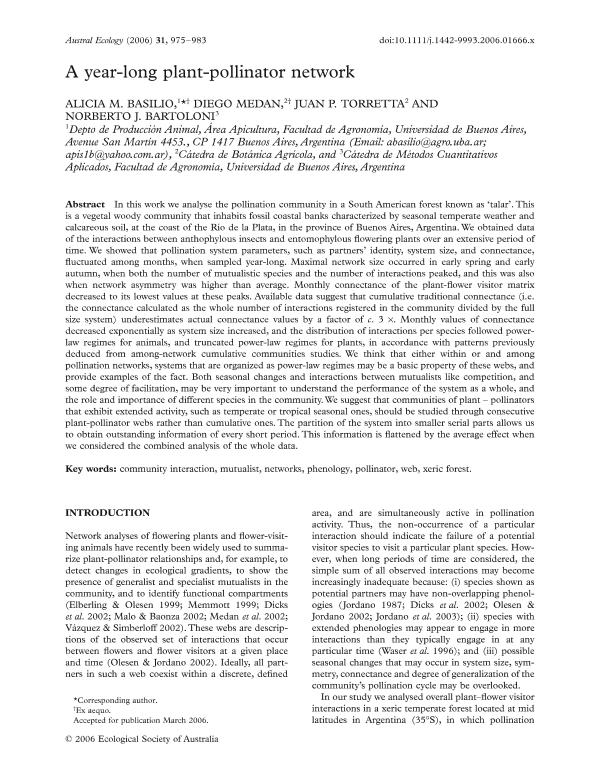Mostrar el registro sencillo del ítem
dc.contributor.author
Basilio, Alicia Mabel

dc.contributor.author
Medan, Diego

dc.contributor.author
Torretta, Juan Pablo

dc.contributor.author
Bartoloni, Norberto Jose

dc.date.available
2021-05-20T14:08:40Z
dc.date.issued
2006-12
dc.identifier.citation
Basilio, Alicia Mabel; Medan, Diego; Torretta, Juan Pablo; Bartoloni, Norberto Jose; A year-long plant-pollinator network; Wiley Blackwell Publishing, Inc; Austral Ecology; 31; 8; 12-2006; 975-983
dc.identifier.issn
1442-9985
dc.identifier.uri
http://hdl.handle.net/11336/132335
dc.description.abstract
In this work we analyse the pollination community in a South American forest known as 'talar'. This is a vegetal woody community that inhabits fossil coastal banks characterized by seasonal temperate weather and calcareous soil, at the coast of the Río de la Plata, in the province of Buenos Aires, Argentina. We obtained data of the interactions between anthophylous insects and entomophylous flowering plants over an extensive period of time. We showed that pollination system parameters, such as partners' identity, system size, and connectance, fluctuated among months, when sampled year-long. Maximal network size occurred in early spring and early autumn, when both the number of mutualistic species and the number of interactions peaked, and this was also when network asymmetry was higher than average. Monthly connectance of the plant-flower visitor matrix decreased to its lowest values at these peaks. Available data suggest that cumulative traditional connectance (i.e. the connectance calculated as the whole number of interactions registered in the community divided by the full size system) underestimates actual connectance values by a factor of c. 3 ×. Monthly values of connectance decreased exponentially as system size increased, and the distribution of interactions per species followed power-law regimes for animals, and truncated power-law regimes for plants, in accordance with patterns previously deduced from among-network cumulative communities studies. We think that either within or and among pollination networks, systems that are organized as power-law regimes may be a basic property of these webs, and provide examples of the fact. Both seasonal changes and interactions between mutualists like competition, and some degree of facilitation, may be very important to understand the performance of the system as a whole, and the role and importance of different species in the community. We suggest that communities of plant - pollinators that exhibit extended activity, such as temperate or tropical seasonal ones, should be studied through consecutive plant-pollinator webs rather than cumulative ones. The partition of the system into smaller serial parts allows us to obtain outstanding information of every short period. This information is flattened by the average effect when we considered the combined analysis of the whole data.
dc.format
application/pdf
dc.language.iso
eng
dc.publisher
Wiley Blackwell Publishing, Inc

dc.rights
info:eu-repo/semantics/openAccess
dc.rights.uri
https://creativecommons.org/licenses/by-nc-sa/2.5/ar/
dc.subject
COMMUNITY INTERACTION
dc.subject
MUTUALIST
dc.subject
NETWORKS
dc.subject
PHENOLOGY
dc.subject
POLLINATOR
dc.subject
WEB
dc.subject
XERIC FOREST
dc.subject.classification
Ecología

dc.subject.classification
Ciencias Biológicas

dc.subject.classification
CIENCIAS NATURALES Y EXACTAS

dc.title
A year-long plant-pollinator network
dc.type
info:eu-repo/semantics/article
dc.type
info:ar-repo/semantics/artículo
dc.type
info:eu-repo/semantics/publishedVersion
dc.date.updated
2021-05-11T18:28:10Z
dc.journal.volume
31
dc.journal.number
8
dc.journal.pagination
975-983
dc.journal.pais
Reino Unido

dc.journal.ciudad
Londres
dc.description.fil
Fil: Basilio, Alicia Mabel. Consejo Nacional de Investigaciones Científicas y Técnicas. Oficina de Coordinación Administrativa Parque Centenario; Argentina. Universidad de Buenos Aires. Facultad de Agronomia. Departamento de Producción Animal. Cátedra de Avicultura, Cunicultura y Apicultura; Argentina
dc.description.fil
Fil: Medan, Diego. Universidad de Buenos Aires. Facultad de Agronomía. Departamento de Recursos Naturales y Ambiente. Cátedra de Botánica Agrícola; Argentina. Consejo Nacional de Investigaciones Científicas y Técnicas. Oficina de Coordinación Administrativa Parque Centenario; Argentina
dc.description.fil
Fil: Torretta, Juan Pablo. Universidad de Buenos Aires. Facultad de Agronomía. Departamento de Recursos Naturales y Ambiente. Cátedra de Botánica Agrícola; Argentina. Consejo Nacional de Investigaciones Científicas y Técnicas. Oficina de Coordinación Administrativa Parque Centenario; Argentina
dc.description.fil
Fil: Bartoloni, Norberto Jose. Universidad de Buenos Aires. Facultad de Agronomía. Departamento de Métodos Cuantitativos y Sistemas de Información; Argentina
dc.journal.title
Austral Ecology

dc.relation.alternativeid
info:eu-repo/semantics/altIdentifier/url/https://onlinelibrary.wiley.com/doi/full/10.1111/j.1442-9993.2006.01666.x
dc.relation.alternativeid
info:eu-repo/semantics/altIdentifier/doi/https://doi.org/10.1111/j.1442-9993.2006.01666.x
Archivos asociados
